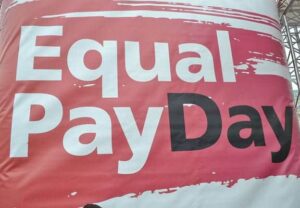
Today is Equal Pay Day, a date that identifies the extra months women must work to earn what men earned during the 12 months of the previous year. Equal Pay Day was originated by the National Committee on Pay Equity in 1996 as a public awareness event to illustrate the gap between men’s and women’s wages, and has served to bring the issues of wage inequality to the forefront.
According to a study by the American Association of University Women in 2014, women working full time in the United States typically were paid just 79 percent of what men were paid, a gap of 21 percent. The gap has narrowed since the 1970s, due in large part to women’s progress in education and workforce participation and to men’s wages rising at a slower rate. But progress has stalled in recent years, and the pay gap does not appear likely to go away on its own.
One great way to close the gap and move closer to pay equality is to get more women into leadership positions. The National Partnership for Women and Families suggests that for women to achieve full workplace and wage equality, they must receive fair treatment in the workplace and have access to good jobs that pay decent wages. And that is proving to be true according to new research by the Apollo Research Institute. Women in leadership are paving the way and creating stronger, more competitive organizations and redefining career paths for aspiring female leaders.
“Gender equality is not a female issue,” said Shelley Zalis, chief executive and founder of The Girls’ Lounge at World Economic Forum’s (WEF) annual meeting in Davos earlier this year. “It’s a social and economic issue, and a business imperative.”
And she’s right. Research shows that companies with more diverse workforces have better financial returns, which benefits everyone. Companies with more women on their boards perform better. Period. Numbers don’t lie, but they can definitely tell stories. Case in point:
- A recent Catalyst report The Bottom Line: Corporate Performance and Women’s Representation on Boards found Fortune 500 companies with the highest representation of women board directors attained significantly higher financial performance in three important measures:
- Return on Equity: 53 percent higher.
- Return on Sales: 42 percent higher.
- Return on Invested Capital: 66 percent higher.
- A recently published study from the Peterson Institute reports that companies with at least 30% female leaders—specifically in senior management—had net profit margins up to 6 points higher than companies with no women in senior management. That is a 15% increase in profitability.
- In 2015, McKinsey & Co.found that companies in the top quartile for gender diversity are 15% more likely to financially outperform their counterparts in the lower quartile.
- McKinsey also found that companies with more balanced leadership do a better job recruiting and retaining talented workers, leading to cost reductions associated with replacing top executives.
- In 2014, MIT researchers found that a more even gender split not only leads to happier, more productive employees, it can increase revenue by 41%.
- A report by Sodexo showed 42% better profit margins and 53% higher average shareholder returns when one-third of the board members are women.
- Another McKinsey & Co. study found that firms with gender-balanced executive committees had a 56 percent higher operating profit than companies with male-only committees.
It is critically important that senior leaders commit to gender diversity. Although 74 percent of companies report that gender diversity is a top CEO priority, less than half of employees surveyed believe that to be true. To make headway, companies need to invest time and money in gender diversity. This makes for a happier workplace, and a more profitable one.
My Leading Women co-author Gloria Feldt founded Take The Lead Women for this very reason. Take The Lead prepares, develops, inspires, and propels women to take their fair and equal share of leadership positions across all sectors by 2025. It’s today’s women’s movement, the needed game changer, a unique way for women to embrace power and leadership parity. It’s important to support this work, which is why Women Connect4Good, Inc., is underwriting Gloria’s next Train-the-Trainer in Santa Barbara, April 20-21. (application here).
We need to use the power of our voices, keep the conversation going, point out injustices in our communities and in the workplace, and support legislation. And most importantly we need to join hands with our sisters and unite our voices, our actions, and our strength. That’s how change happens, and how together we can achieve full workplace and wage equality.

